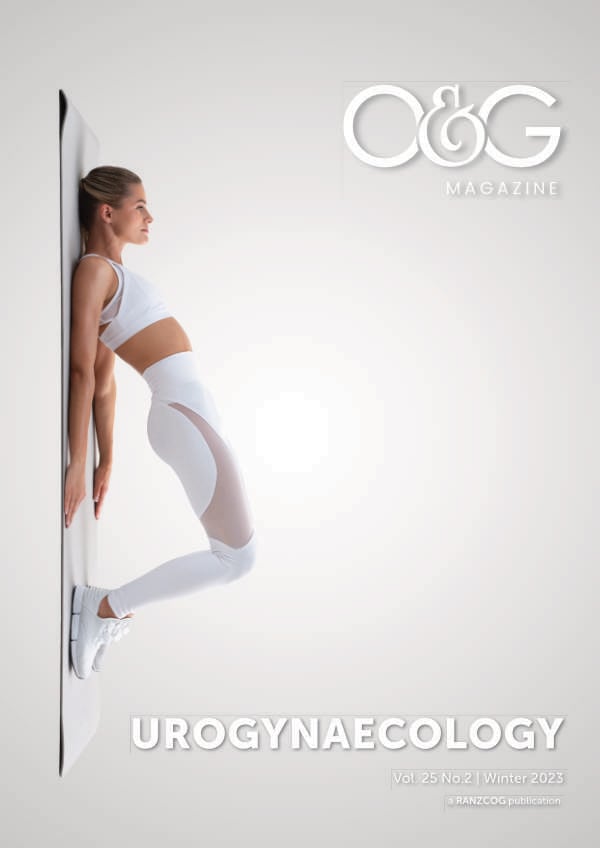Welcome to our Urogynae issue – the first since our issue of ‘Pelvic Floor’ in 2014. We have picked the brains of an interesting and diverse group of people – senior and junior, generalists and specialists, nurses and physiotherapists, and patient advocates. Our topics range from grass roots issues – managing bladders after birth, to professional development and systems improvement; exciting developments in research and sobering reminders that whatever our problems, the political will of nations is not fast enough to alleviate the suffering faced by millions of birthing women around the world. Please remember that this is not a book chapter about urogynaecology, not an issue of Current Opinion. Please write to us and tell us what needs to be in the next issue!
All the articles in this issue demonstrate the need for holistic, evidence informed woman-centred pelvic floor care, whether the care is preventative, nonsurgical, surgical or treating complications, and we need to instil this approach in the profession through appropriate clinical and cultural training. This need is no more exemplified than by the controversy, adverse media coverage and political attention arising from the use of mesh in urogynaecology and the emergence of adverse events, most importantly for the patient but also for the profession and society as a whole. It is worth briefly revisiting this history.
In 1996, the early report of ‘An ambulatory surgical procedure under local anaesthetic for the treatment of female urinary incontinence’ looked very promising,1 what could be better? While the midurethral sling (MUS) may have become the ‘gold standard’ with a growing body of evidence to support its utility and safety compared to other surgical treatment options, it was initially introduced with inadequate regulatory controls, minimal clinical evaluation, no longer-term studies, no formal surgical training pathways, and minimal credentialing or auditing requirements.2 This led to a large number of MUS and pelvic organ mesh products being developed and promoted by industry, and taken up enthusiastically by clinicians, despite importantly different insertion techniques and risk:benefit profiles that have contributed to adverse outcomes.
As experience with pelvic mesh grew, concerns about its use in the vagina emerged resulting in the first regulatory action in 2008 when the FDA issued a warning,3 with posterior compartment mesh being a particular focus. By extension, these concerns have now grown to include the MUS with the volume of MUS procedures falling from a peak of over 8000 in 2010 to less than 2500 per year,4 mirroring the rise in women’s concerns about mesh surgery. Their stories gained the attention of the media, lawyers, regulators, and politicians with heartbreaking stories of life-changing physical and psychosocial harms stemming from surgery involving mesh. Consumerled concerns have resulted in litigation, government and parliamentary enquiries, and the withdrawal from the market of the majority of mesh products used in the vagina.2
In the UK, a mesh ‘pause’ occurred five years ago and shows no sign of being lifted, with mesh only possible under ‘a high vigilance pathway’ and rarely used.5 In Australia the 2018 Senate enquiry into mesh6 led to the formation of Australian Commission on Safety and Quality in Healthcare (ACSQHC) and jurisdictional reference groups, including consumers and a range of experts, resulting in a range of resources to guide clinical practice, such as consumer focused decision tools, care pathways, credentialing guidance, enhanced multidisciplinary meetings, a service model framework and strengthened clinical guidelines.7 This also led to the establishment of the Australasian Pelvic Floor Procedure clinical quality Registry.8 In New Zealand, the 2018 enquiry into mesh, under a Restorative Justice framework, led to the establishment of a Mesh Roundtable to oversee agreed actions.9 Progress has been slow and concerned consumers have petitioned the Health Select committee to pause the availability of MUSs. This call is being echoed by the Health and Disability Commissioner, following a surge in complaints, and the Accident Compensation Commission following increasing claims for mesh-related harm and by Health Quality and Safety.10 It seems inevitable that the availability of MUSs will change and at best be heavily regulated, with significant repercussions on access to SUI surgery for women and reduced ability for gynaecologists outside of a formal urogynaecology training pathway to maintain and develop surgical skills for the treatment of SUI in New Zealand.
More broadly, the perfect storm of the reductions in surgical volume associated with COVID-19 for elective procedures like MUS,11 withdrawal of pelvic floor products and less experience with older native tissue procedures,12 and less patient demand for surgery, is having a significant impact on training and maintenance of skills, also affecting geographical equity of access to pelvic floor surgeons. This only increases the challenges for those women suffering and seeking care for pelvic floor symptoms. From an evidence standpoint, not only has the withdrawal of products diminished the body of scientific literature for many pelvic floor procedures, in some cases taking us back 30 years, it increases the difficulty of developing evidence for new products. This particularly affects those with complicated or recurrent pelvic floor symptoms needing surgical treatment.
So where does this leave us? Evidence on the long-term performance of MUS, particularly the TVT, continues to be good and the risk of short- to medium-term adverse events is low, although like other surgical approaches, efficacy does fall off over time.13–15 What remains of concern is the small percentage of women who remain with severe symptoms despite further treatment, including mesh removal. Estimates of the proportion of women with severe ongoing symptoms is difficult to ascertain with certainty, varying with the population studied and the measures used. Recent Australian data suggests voiding dysfunction requiring surgical intervention at 3%, rates of excision for mesh exposure or extrusion at 2%, and partial or complete excision for pain 1% at median of 10 years from index surgery.16
Most pelvic floor gynaecological surgeons recommend MUS as an effective SUI procedure,17 in routine cases, supported by the RANZCOG MUS position statement,18 with a very low incidence of serious mesh-related long-term problems after treatment, provided women are offered a MUS only after
- a recommendation of supervised pelvic floor exercised by a physiotherapist or continence nurse
- a careful preoperative workup, including urodynamics where appropriate
- receiving detailed information about the surgical options, not limited by the surgeon’s own skillset, including benefits, complications and factors affecting outcomes
- a discussion involving a detailed and fully informed consent, taking into account the patient needs and preferences
and are operated on by well-trained, credentialed surgeons with prospective auditing of clinical and patient reported outcomes. While the incidence of complications may be low, those who do report problems need clinicians to take their concerns seriously, investigate them appropriately and refer them on to others if they are unable to find a solution.
There are many lessons in this mesh journey. We need to ensure we are keeping the patient at the centre of care, that clinicians can develop and maintain their surgical skills to continue offering MUS procedures where indicated and equitably, and that we take a more judicious and evidence-based approach to the introduction of new techniques and products before adoption into routine clinical practice. Current clinical care and patient-reported outcomes should also be captured using audit tools or a quality register to support real-time evaluation of care delivery; and that clinicians must actively engage with their patients as partners in their care.
References
- Ulmsten U, Henriksson L, Johnson P, Varhos G. An ambulatory surgical procedure under local anesthesia for treatment of female urinary incontinence. International Urogynecology Journal. 1996;7(2):81–6.
- Daly JO, Ahern S, Herkes R, O’Connell HE. The Australasian pelvic floor procedure registry: not before time. ANZJOG. 2019;59(4):473–6.
- FDA. Urogynecologic Surgical Mesh – Update on the Safety and Effectiveness of Transvaginal-Placement for Pelvic Organ Prolapse. 2008. Available from: https://www.fda.gov/files/ medical%20devices/published/Urogynecologic-Surgical-Mesh- -Update-on-the-Safety-and-Effectiveness-of-Transvaginal- Placement-for-Pelvic-Organ-Prolapse-%28July-2011%29.pdf
- AIHW. Procedures data cubes 1995/2020. 2023. Available from: https://www.aihw.gov.au/reports/hospitals/procedures-datacubes.
- Government announces strict rules for the use of vaginal mesh. GOV.UK. Available from: https://www.gov.uk/government/ news/government-announces-strict-rules-for-the-use ofvaginal- mesh
- Australia Parliament Senate Community Affairs Reference Committee. Number of women in Australia who have had transvaginal mesh implants and related matters. 2018.
- Transvaginal Mesh | Australian Commission on Safety and Quality in Health Care. Available from: https://www. safetyandquality.gov.au/our-work/health-conditions-andtreatments/ transvaginal-mesh
- APFPR. Available from: https://apfpr.org.au/
- An evaluation of a restorative process to address harm from surgical mesh. Ministry of Health NZ. Available from: https:// www.health.govt.nz/news-media/news items/evaluationrestorative- process-address-harm-surgical-mesh
- Wailling J, Marshall C, Wilkinson J. Hearing and Responding to the Stories of Survivors of Surgical Mesh: Ngā korero a ngā mōrehu–he urupare. 2019.
- Fornari A, Toledo LGM, Canalini AF, et al. Impact of COVID-19 on surgical procedures for stress urinary incontinence in the Brazilian public health system. Int Urogynecol J. 2023 Feb 22. Available from: https://link.springer.com/10.1007/s00192-023- 05475-8
- McCormack L, Nesbitt-Hawes E, Deans R, et al. A review of gynaecological surgical practices for trainees and certified specialists in Australia by volume using MBS and AIHW databases. ANZJOG. 2022;62(4):574–80.
- Keltie K, Elneil S, Monga A, et al. Complications following vaginal mesh procedures for stress urinary incontinence: an 8 year study of 92,246 women. Sci Rep. 2017;7(1):12015.
- Dejene SZ, Funk MJ, Pate V, Wu JM. Long-Term Outcomes After Midurethral Mesh Sling Surgery for Stress Urinary Incontinence. Female Pelvic Medicine & Reconstructive Surgery. 2022;28(4):188–93.
- Karmakar D, Dwyer PL, et al. Long-term effectiveness and safety of open Burch colposuspension vs retropubic midurethral sling for stress urinary incontinence—results from a large comparative study. American Journal of Obstetrics and Gynecology. 2021;224(6):593-e1.
- Kulkarni M, Liu Y, Silagy M, et al. The transvaginal mesh class action: a tertiary teaching hospital experience of all midurethral sling procedures performed between 1999 and 2017. Int Urogynecol J. 2023;(in press).
- Zilberlicht A, Karmakar D, Dwyer PL, et al. Counseling for stress urinary incontinence in the era of adverse publicity around mesh usage: Results from a large-sample global survey. International Journal of Gynecology & Obstetrics. 2023;160(2):579–87.
- RANZCOG. Position statement on midurethral slings. 2022. Available from: https://ranzcog.edu.au/wp-content/ uploads/2022/05/Position-statement-on-midurethral-slings.pdf







Leave a Reply